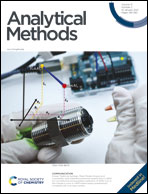Visual detection of different metal ions based on the tug of war between triangular Au nanoparticles and metal ions against mercaptans†
Abstract
Herein, a new colorimetric sensor array was developed for the first time, which can rapidly recognize 9 types of metal ions (e.g., Ni2+, Zn2+, Cd2+, Cu2+, Cr3+, Fe2+, Se2+, Mn2+, and Mg2+). The colorimetric characteristics of the sensor array were closely related to the oxidation etching of the triangular gold nanoplates (AuNPLs) by hydrogen peroxide (H2O2), catalyzed by horseradish peroxidase (HRP). In the design, two types of thiols (glutathione (GSH) and cysteine (Cys)) as recognition elements were employed to construct the sensor units (AuNPLs/GSH and AuNPLs/Cys) and adjust the etching degrees of AuNPLs in the presence of various metal ions. The differential binding affinities between metal ions and thiols will lead to different degrees of oxidation etching of AuNPLs with hydrogen peroxide, exhibiting characteristic colors, which can be visually distinguished by the naked eye. Thus, the colorimetric sensor array provides a new way for the discrimination of various metal ions, thereby simplifying the water quality analysis.



 Please wait while we load your content...
Please wait while we load your content...